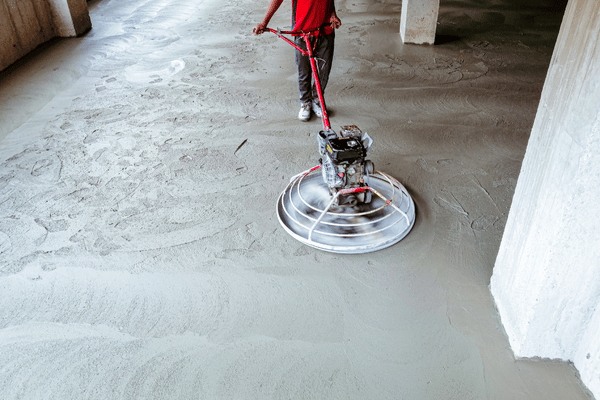Polished concrete floors have moved from warehouses to living rooms. This flooring choice offers style and function that today's homeowners want. In Waco and across Texas, more people choose this option for good reasons.
The trend makes sense. These floors last for decades with minimal care. They cost less than many alternatives over time. Plus, you can customize the look to match any style.

Polished concrete turns your existing concrete slab into a finished surface. Professional teams use machines with diamond grinding discs to smooth the concrete in stages. They apply a densifier chemical to harden the surface. Then they keep grinding with finer tools until the floor shines.
The process isn't DIY work. You need industrial equipment and expert knowledge. A contractor handles prep work like filling cracks and removing old adhesives. This ensures a smooth, uniform finish.
You can add color through dye or staining during polishing. The final step usually includes sealing to protect the surface and boost the shine. The result looks like polished stone with depth and reflectivity.
These concrete floors can last 50 years or more without replacement. The surface resists scratches that gouge hardwood. It won't crack like tile under impact. This longevity means huge cost savings over time. You won't reinstall or repair every few years. The durability rivals any flooring on the market.
Maintenance needs are minimal. No waxing required. No special cleaners to buy regularly. Just sweep and damp mop occasionally for cleaning. The dense surface resists stains naturally. It doesn't trap dust or allergens like carpet does. Pet owners love that odors and accidents wipe away cleanly. This ease of maintenance saves time and budget.
Cost matters for most homeowners. Polished concrete typically runs $3 to $12 per square foot for installation costs. Quality hardwood often exceeds $10 per square foot. High-end tile costs similar to or more than. Since the concrete slab becomes your floor, you skip buying separate materials. Over the decades, the maintenance cost savings add up significantly. The initial budget investment pays off through durability.
Today's polishing offers rich design options. Choose your finish level from matte to high-gloss. Pick from unlimited color choices using concrete dye or acid staining. You can get earthy browns, cool grays, bold jewel tones, or dramatic black through dye application. Some homeowners add patterns through scoring or expose aggregate for texture.
This aesthetic versatility fits many interior design styles. Modern lofts look natural with sleek gray. Farmhouse kitchens work with warm tones through color staining. The appearance adapts to your taste. You get design styles ranging from industrial to contemporary.
Polishing concrete floors creates a finish that reflects light beautifully, brightening rooms and reducing lighting costs. The material’s thermal mass helps regulate temperature as concrete floors absorb heat by day and release it slowly. Surfaces stay cool in summer and hold warmth in winter, improving energy efficiency and lowering bills for households and commercial spaces.
Unlike wood that warps or laminate that swells, polished concrete handles water. The polishing process densifies the surface so spills don't soak in. This moisture resistance makes it perfect for basements or bathrooms. If pipes leak, the floor dries fine without repair.

The appearance you want is achievable through choices made during grinding. Grinding depth determines aggregate exposure. Light grinding keeps things smooth and uniform. Deeper grinding reveals stones for a terrazzo effect through multiple grinding passes.
Color gets added through a dye that penetrates the concrete. You're not limited to gray for color. Want sage green? Done through dye. Terracotta? No problem with staining. The color won't peel like paint because it's in the material.
Finish level changes the feel. High-gloss finish creates drama and reflects like marble. Satin finish hides footprints better and suits relaxed living spaces. Both deliver durability. The choice affects appearance and how much dust shows. The surface finish you select impacts the home atmosphere.
These design styles work everywhere. Industrial lofts love exposed aggregate. Contemporary homes prefer smooth, dyed surfaces. Even traditional spaces can use warm tones to blend with wood accents. The aesthetic versatility means endless possibilities.
Wood offers warmth but scratches easily. Pet claws and furniture legs leave marks on the surface. Water damages wood floors permanently. You'll refinish hardwood every few years at significant cost. Concrete outlasts wood by decades with no refinishing. However, wood feels softer underfoot and provides better comfort. For comfort, add rugs over concrete in spots where you stand often.
Tile handles water well but has grout lines. Grout attracts dirt and stains. It cracks over time through surface damage. Cleaning grout is tedious. Polished concrete has no grout because it's one continuous surface. Tile can chip if you drop heavy items. Concrete rarely develops cracks from impact. The installation cost for quality tile often exceeds concrete pricing.
The carpet feels soft and warm. But it stains, wears out in traffic areas, and harbors allergens. You'll replace carpet every 5 to 10 years. Concrete never frays. Spills wipe clean through simple cleaning. No odors remain. For living spaces, concrete makes sense. Add area rugs where you want softness.
Laminate costs less initially but doesn't last. The surface layer can wear through and show damage. Water makes it swell and warp. Even good vinyl planks may curl at the edges. Concrete goes all the way through with no decorative layer to damage. You might replace the laminate twice or three times during one concrete floor's life. That budget advantage disappears fast. These flooring options can't match concrete durability.
Important factors to weigh before choosing polished concrete floors
Concrete is hard on the surface. Standing for hours can tire your legs and reduce comfort. Dropped dishes will shatter. The coldness bothers some people in winter.
Concrete slabs can develop hairline cracks from settling or temperature changes. Small cracks are mostly cosmetic. Major cracks need contractor repair before polishing.
High-gloss finishes show footprints and dust easily on the surface. You'll need more frequent cleaning to maintain that pristine appearance.
You can't DIY this project. The grinding equipment costs thousands for proper grinding. A bad job looks terrible and hurts resale value.
Concrete is hard on the surface. Standing for hours can tire your legs and reduce comfort. Dropped dishes will shatter. The cold bothers some people in winter. Solutions exist, though. Use anti-fatigue mats where you stand. Add rugs for warmth. Consider radiant heating during installation to eliminate cold completely.
Concrete slabs can develop hairline cracks from settling or temperature changes. Small cracks are mostly cosmetic and add character to the appearance. Major cracks need contractor repair before polishing. Contractors can fill them, but lines may show faintly on the surface. If you want perfection, discuss options upfront with your contractor.
High-gloss finishes show footprints and dust easily on the surface. You'll need more frequent cleaning to maintain that pristine appearance. Choosing a satin finish helps hide marks. Light colors hide dust better than dark ones through better aesthetics.
You can't DIY this project. The grinding equipment costs thousands for proper grinding. Proper prep work and technique take years to master. A bad job looks terrible and hurts resale value. Always hire an experienced contractor. Check references carefully for quality installation work.

Polished concrete delivers serious advantages for modern homes. The durability, low maintenance, and aesthetic versatility appeal to practical homeowners. Installation cost compares well to premium flooring alternatives. Over the decades, you'll save significantly on maintenance and budget.
The disadvantages are manageable. Area rugs solve comfort concerns. Professional installation ensures quality. Small cracks often add character to the surface rather than detracting from home value.
For Waco homeowners building or renovating, polished concrete makes sense. It suits the climate perfectly through energy efficiency. The surface stays cool in brutal summers. Modern Texas homes embrace this look as buyers want move-in-ready spaces with minimal upkeep.
Before committing, evaluate your existing concrete slab condition. Discuss prep work needs with your contractor during the planning phase. Ask about color samples using different dye options. Check their past projects to verify the quality of polishing work and finish results.
Done right, polished concrete transforms your home. It's a flooring solution that works hard and looks great for decades with simple maintenance needs and long longevity.
Stop settling for flooring that needs constant care. Polished concrete offers the durability and style your home deserves. Contact FloorDoctor TX today for a free consultation. Our experienced contractor team will assess your space, discuss your design vision, and provide a detailed estimate. Let's create the polished concrete floor you'll love for years to come.
Polished concrete can last 50 years or more with proper care. The surface doesn't wear out like other flooring because it's a solid material all the way through.
Yes, you can polish concrete in any room with a concrete slab underneath. It works great in kitchens, living spaces, basements, and even bathrooms through its moisture resistance.
Quality polished concrete can boost resale value by signaling a modern, well-maintained home. Buyers appreciate the low maintenance needs and contemporary appearance it provides.
The hardness is the main concern for most people. The surface has no give, which can tire your legs during long standing periods. Area rugs and mats help address this issue.

